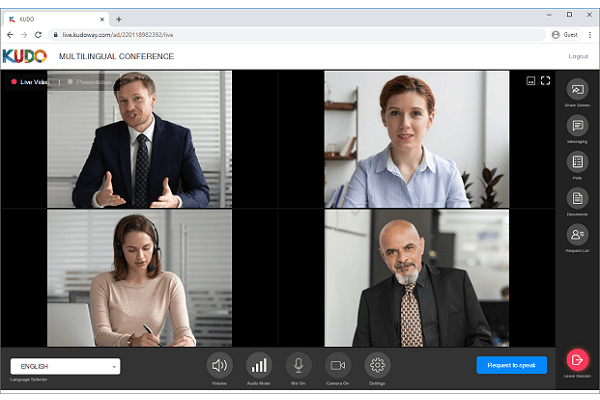Oh my word: multilingual video conferencing
The Kudo platform enables multilingual video conferencing calls with a few participants or several thousand. Sean Carroll finds out how it works and the benefits for B2B conferencing.
In our globalised market, technology enables multinational companies and organisations to operate anywhere.
Although this has helped nations to grow socially, culturally and financially, the issue of language can still be a barrier. KUDO, a ‘language as a service’ platform, aims to counter this. It’s a cloud-based video conferencing platform connecting users with an interpreter network that meets the needs of the conference call.
ADVERTISEMENT
KUDO co-founder and chief executive Fardad Zabetian says language is an enabler like no other, and also a human right.
“It was my dream to expand the multilingual space by making it accessible for companies and individuals so they could meet and communicate in their own language.
“It’s also much more pleasant to be able to speak in one’s own language, and it makes business sense.”
The service allows speakers to leave translation to a third party. This can be crucial in getting the message across, as people can fully express themselves in their native language.
KUDO, with a network of more than 1,500 certified interpreters can, accommodate about 120 languages. All interpreters have gone through extensive training and are already certified
interpreters – which means they know more than just the language.
One of KUDO’s co-founders is Ewandro Magalhaes, a former chief interpreter for the United Nations systems in Geneva. This gives KUDO access to an extensive network of professional interpreters.
To start a KUDO conference, users must make a booking. Fardad says the aim by the last quarter of 2020 is to allow bookings down to one hour before the scheduled time.
Participants are greeted by the KUDO interface, or whichever KUDO-integrated conferencing solution they are using.
The one major difference with the KUDO interface is the option of changing the language.
Language options are selected by the call host when booking.
Fardad says the most recent addition is the ability to select a sign language.
“Someone who is deaf can choose American Sign Language, for example, and a small window will pop up with live video of a sign interpreter.
“You can have as many as ten different sign language interpreters on the call, but each one is signing into a particular channel. If you’re following in American Sign Language, and then switch to British Sign Language, you will automatically see a different interpreter.”
It’s fascinating to experience translation in real time, and KUDO offers a free demo through its website.
Fardad says the system operates on a latency of less than 200ms.
“That’s pretty good for point-to-point AV conferencing. Interpreters receive a high-definition video feed of the presentation, with perfectly synched audio coming from the floor or from whoever is speaking.”
When interpreters listen to a speaker they start to translate and speak into their own microphone. That audio is then sent to conference call channels that have the particular language selected.
Fardad says this allows the original speaker’s tone, intonation, stress and other vocal characteristics to come through.
“AI and machine learning are here to stay. And while they consistently outperform humans at such tasks as driving, medical diagnostics, analytical predictions and gaming, they fall miserably short of expectations when it comes to language in general and language interpretation in particular.”
When a call has finished, the administrator or host of the call can look through the stats – languages used, where people where calling from, documents shared, recordings, etc. KUDO recently integrated with Microsoft Teams, offering the use of more than 120 additional languages.
“Teams is roughly 60% of what people are using on a daily basis for conferencing, and about 13 million active users now can be multilingual,” Fardad says.
“That’s a key for us: keeping the ecosystem that users are in – Office 365 – while being able to jump on a multilingual call though Teams.”
The KUDO platform was built to accommodate about 3,000 people per language. If 15 languages are involved then a staggering 45,000 people can listen in at once.
Because of KUDO’s expansive design, it can be used for more than conferencing. Other applications include multilingual streaming, remote participation, webinars/training, global product
launches and industry conferences, etc.
KUDO also works with mobile devices, so someone could give a TED Talk in their native tongue and thousands of participants could hear it in their selected language.
When asked if this is the future of conferencing, Fardad responds: “I wouldn’t call it the future. It’s already here. It’s the new standard.”
-
ADVERTISEMENT
-
ADVERTISEMENT
-
ADVERTISEMENT
-
ADVERTISEMENT

